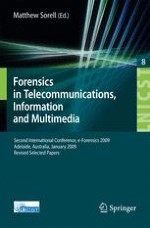The Second International Conference on Forensic Applications and Techniques in Telecommunications, Information and Multimedia (e-Forensics 2009) took place in Adelaide, South Australia during January 19-21, 2009, at the Australian National Wine Centre, University of Adelaide. In addition to the peer-reviewed academic papers presented in this volume, the c- ference featured a significant number of plenary contributions from recognized - tional and international leaders in digital forensic investigation. Keynote speaker Andy Jones, head of security research at British Telecom, outlined the emerging challenges of investigation as new devices enter the market. These - clude the impact of solid-state memory, ultra-portable devices, and distributed storage – also known as cloud computing. The plenary session on Digital Forensics Practice included Troy O’Malley, Que- sland Police Service, who outlined the paperless case file system now in use in Que- sland, noting that efficiency and efficacy gains in using the system have now meant that police can arrive at a suspect’s home before the suspect! Joseph Razik, represe- ing Patrick Perrot of the Institut de Recherche Criminelle de la Gendarmerie Nati- ale, France, summarized research activities in speech, image, video and multimedia at the IRCGN. The plenary session on The Interaction Between Technology and Law brought a legal perspective to the technological challenges of digital forensic investigation.
